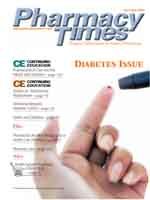Publication
Article
Pharmacy Times
Drug Interactions with Digoxin: The Role of P-glycoprotein
One of the most widely studied drug interactions is the interaction between digoxin and quinidine. Patients who receive the combination almost always will have a significant elevation in their digoxin plasma concentrations and can suffer digoxininduced toxicity, including arrhythmias, anorexia, altered color vision, and mental changes. One of the first case reports of this interaction was published in 1968.1 In 1978, several prospective studies of the interaction were published, noting a 2- to 3-fold increase in digoxin concentrations following the coadministration of quinidine.
Since that time, several other drugs?including cyclosporine, erythromycin, clarithromycin, propafenone, itraconazole, amiodarone, verapamil, and diltiazem?were noted to increase digoxin plasma concentrations. Although some investigators noted a reduction in digoxin renal and total body clearance, the underlying mechanism for these interactions remained undefined.
Some investigators suggested that antibiotics might increase digoxin absorption by inactivating gastrointestinal bacteria thought to metabolize digoxin in the gut.2 This mechanism, however, would appear to be incapable of raising digoxin concentrations 2- to 3-fold, because digoxin is well absorbed with a bioavailability of about 75%. Assuming that the intestinal bacteria were responsible for this reduction of digoxin absorption, the greatest increase in bioavailability one could expect would be about 25%. At that point, the bioavailability of digoxin would be 100%, and no further increase in concentration could occur by this mechanism. Another mechanism for the interaction was needed to explain the large changes in digoxin concentrations that had been reported.
Starting in 1993, a series of studies identified a mechanism that appears to underlie the digoxin interactions reported with a wide variety of precipitant drugs. It was first noted that cyclosporine reduced the renal tubular secretion of digoxin by inhibiting a renal transporter protein?P-glycoprotein (P-gp).3 In 1996, it was demonstrated that the effect of quinidine on plasma digoxin concentrations was the result of quinidine-induced inhibition of P-gp in the intestine, as well as at sites of digoxin elimination such as the kidney.4
P-glycoprotein is an energy-dependent efflux transporter. Simply stated, Pgp pumps drug molecules out of cells. P-gp is found in the epithelial cells of the intestine (enterocytes) along the apical (luminal) side of the cell. When a drug is taken orally, drug molecules have to pass through the enterocyte to enter the blood. As the molecules diffuse through the enterocyte, P-gp can pick up the molecules and carry them back to the luminal side of the cell, where they are dumped back into the lumen of the intestine. This action prevents drug molecules from reaching the systemic circulation, effectively limiting bioavailability. Because P-gp is found throughout the intestinal tract, it affects the absorption of all susceptible oral drugs, including sustained-release formulations. P-gp also is present in the liver and kidney, where it acts to increase the excretion of drugs by transporting the molecules into the bile and urine, respectively (Figure).
If the activity of P-gp is inhibited, more drug will be absorbed through the enterocytes, and plasma concentrations will increase. In addition, drug that is normally eliminated by P-gp in the bile or urine will accumulate in the body. Thus, when quinidine is coadministered with digoxin, quinidine inhibition of P-gp results in an increase in digoxin absorption and a reduction of digoxin elimination, primarily via the kidney. The elimination of digoxin is so dependent on P-gp that it can be used as a test substance to see whether other drugs affect P-gp activity.
An inducer of P-gp could reduce digoxin plasma concentrations by limiting its absorption from the GI tract and/or by increasing the elimination of digoxin. The effect of rifampin on digoxin plasma concentrations is greater following oral digoxin than intravenous digoxin, indicating that the effect of rifampin may be greater on the absorption of digoxin than on its renal elimination.5 Both rifampin and St. John's wort have been demonstrated to increase P-gp in the intestine and to result in lower plasma digoxin concentrations.
The Table lists some P-gp inhibitors and inducers. Any of these substances will affect digoxin elimination and absorption, although, as with other interactions, the magnitude of the effect will vary considerably. Much more study is needed to evaluate other potential interactions involving digoxin and inhibitors or inducers of P-gp. In the interim, pharmacists should be on the alert for drugs that alter P-gp activity, for they may also cause clinically important changes in digoxin plasma concentrations.
Drs. Horn and Hansten are both professors of pharmacy at the University of Washington School of Pharmacy. For an electronic version of this article, including references if any, visit www.hanstenandhorn.com.







